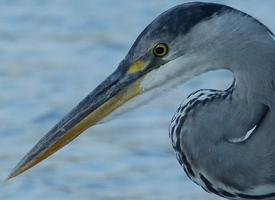
Váhy a míry
| Délka | od 84 do 102 cm |
|---|---|
| Hmotnost | od 1 do 2 kg |
| Délka rozpětí křídel | od 155 do 175 cm |
Stav ohrožení
| Neohrožen |
Popis zvířete
The Grey Heron (Ardea cinerea) is a large and striking bird that belongs to the heron family, Ardeidae. With its long legs, neck, and bill, it is easily recognizable and is found across a wide range of wetlands both in temperate and tropical regions of Europe, Asia, and parts of Africa. This species is known for its adaptability, often seen in habitats ranging from rivers, lakes, and marshes to estuaries, ponds, and even urban parks.Physical Description:
The Grey Heron stands tall, with an average height ranging from 90 to 100 cm (35 to 39 inches) and a wingspan that can stretch up to 155 to 195 cm (61 to 77 inches). It weighs between 1 to 2 kg (2.2 to 4.4 lbs). The bird's plumage is primarily grey on the upper parts and somewhat lighter grey on the underparts. Its head is white with a broad black stripe that extends from the eye to the back of its crest, and it has a powerful, dagger-like yellow bill that turns orange during the breeding season. The legs are long and brownish in color, which turns to a more vivid shade of pink or red as the breeding season approaches.
Behavior and Diet:
Grey Herons are wading birds, often seen standing motionless in shallow water as they wait patiently for prey to come within striking distance. Their diet is varied and mainly consists of fish, which they catch with a lightning-fast thrust of their sharp bill. Besides fish, they also feed on a wide range of aquatic animals such as amphibians, small mammals, insects, and even small birds.
Reproduction:
The breeding season brings out a more social side of the typically solitary Grey Heron. They nest in colonies known as heronries, which can sometimes contain hundreds of nests. These are often located in tall trees but can also be found in reed beds or even on cliffs. The nests are large structures made of sticks, where the female lays between 3 to 5 pale blue eggs. Both parents share the duty of incubating the eggs for about 25 to 30 days. After hatching, the chicks are fed by both parents and fledge the nest after about 50 to 55 days.
Conservation Status:
The Grey Heron is classified as Least Concern by the International Union for Conservation of Nature (IUCN), thanks to its wide distribution and large, stable population. However, it is not without threats. Habitat destruction and pollution, particularly in wetlands, pose significant risks. Despite these challenges, the Grey Heron has shown remarkable adaptability, even benefiting from human-made environments like fish farms and urban parks, which provide ample feeding opportunities.
In summary, the Grey Heron is a fascinating bird that plays a vital role in the ecosystem as a top predator in aquatic environments. Its presence is a testament to the health of wetland habitats, making it an important species for biodiversity and an indicator of environmental quality
Mapa výskytu

Podobná zvířata
Nové fotografie zvířat
Top 10 zvířat
- Dolphin gull (Leucophaeus scoresbii)
- Diana monkey (Cercopithecus diana)
- Moustached guenon (Cercopithecus cephus)
- Galápagos tortoise (Geochelone nigra complex)
- Japanese macaque (Macaca fuscata)
- Russian tortoise (Testudo horsfieldii)
- Stone loach (Barbatula barbatula)
- Greek tortoise (Testudo graeca)
- Common flying dragon (Draco volans)
- Vendace (Coregonus albula)


